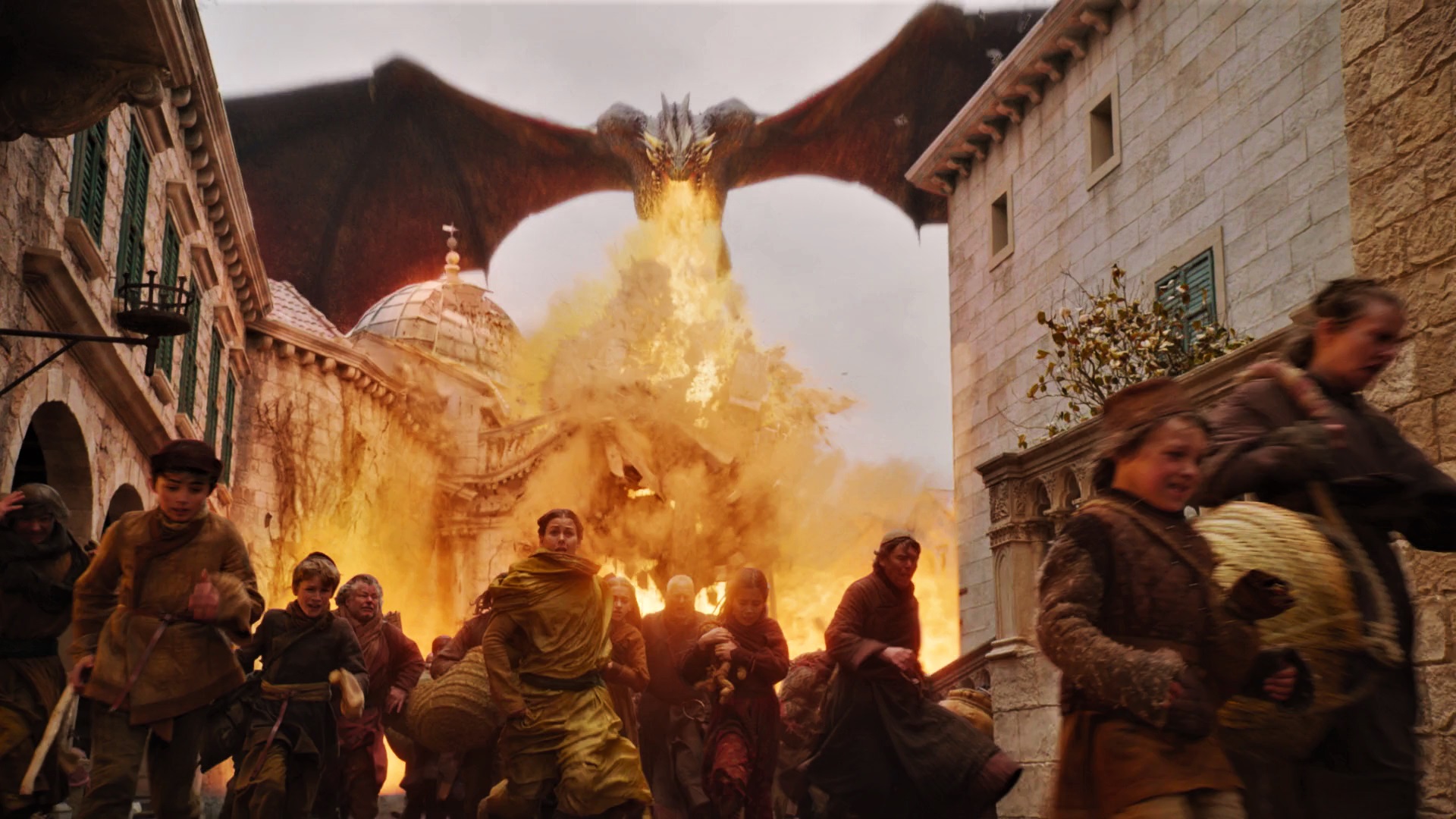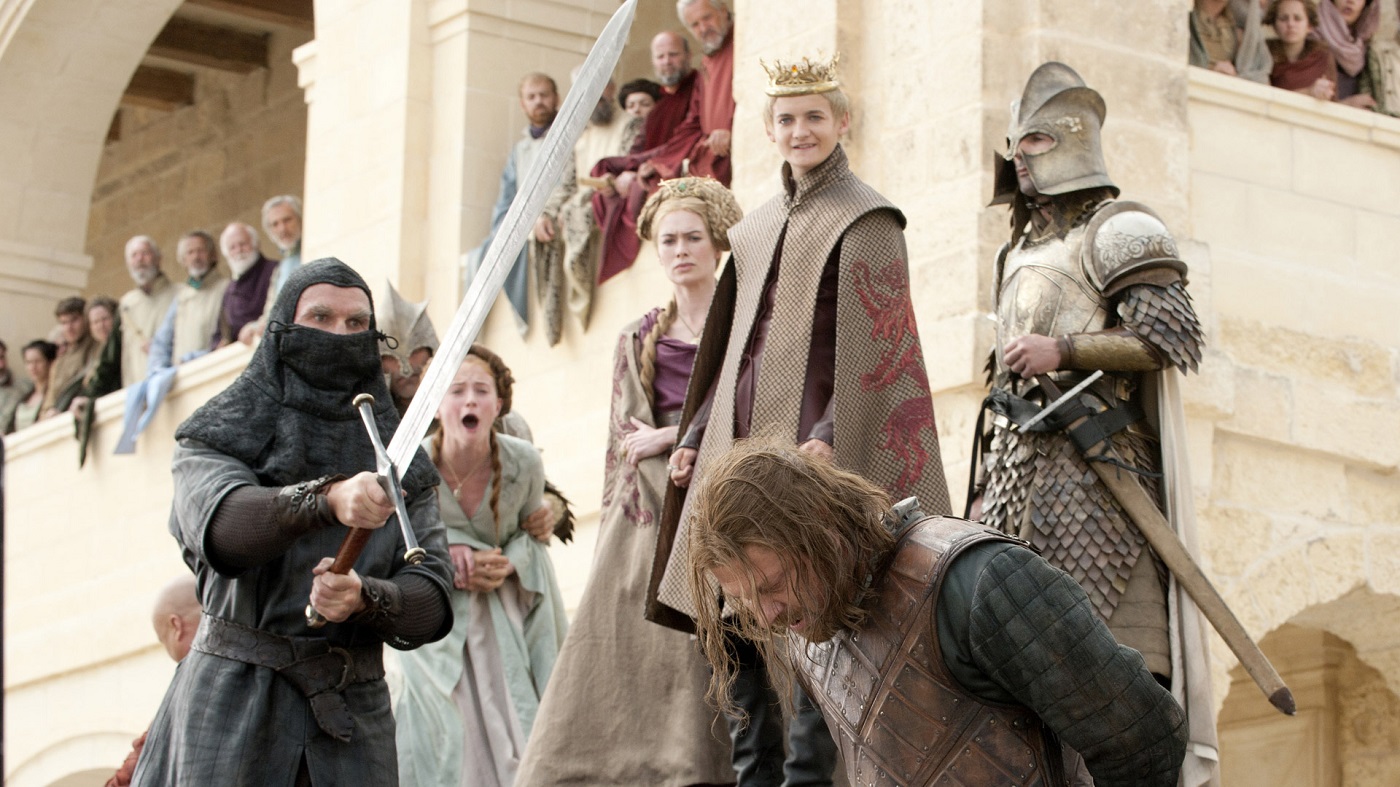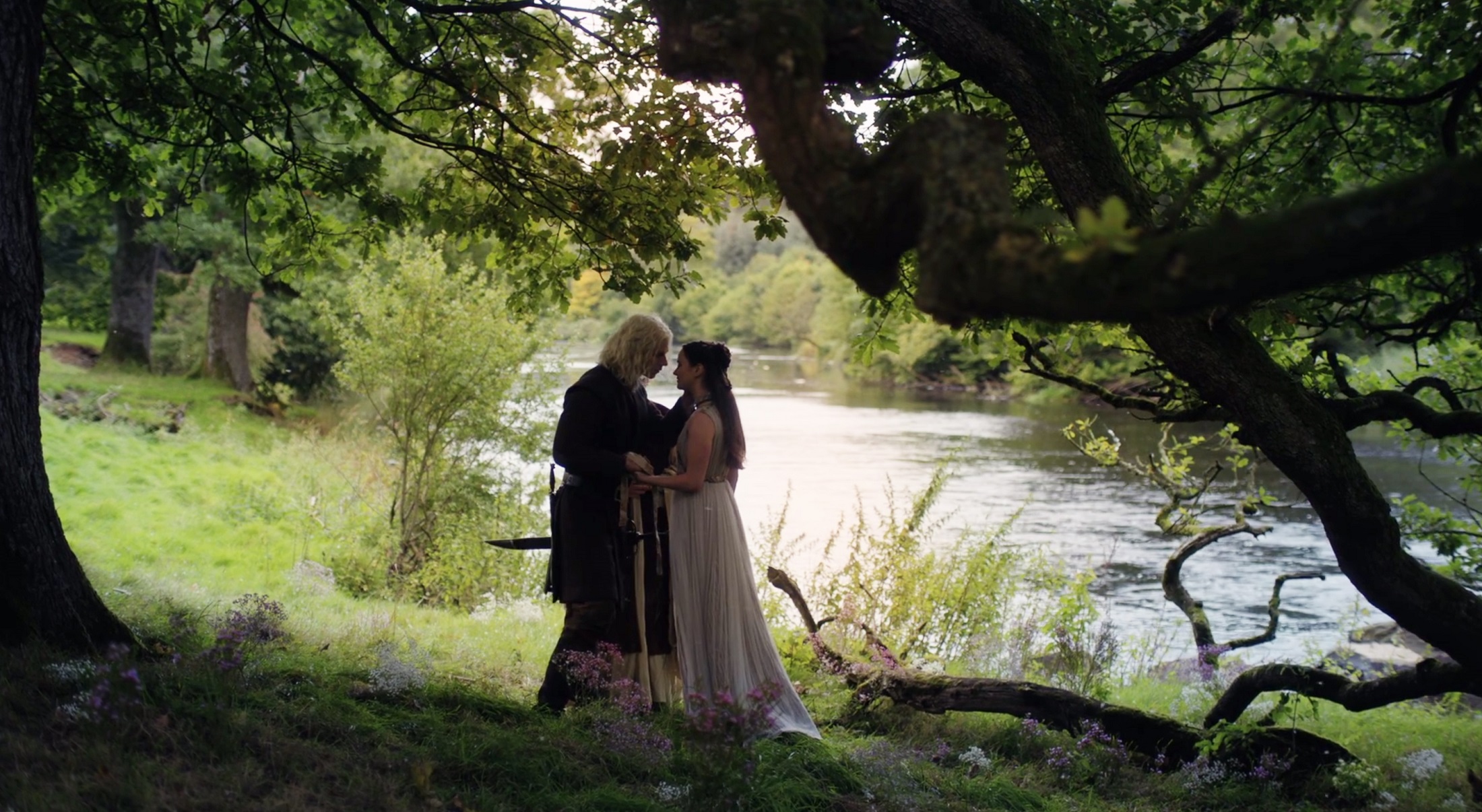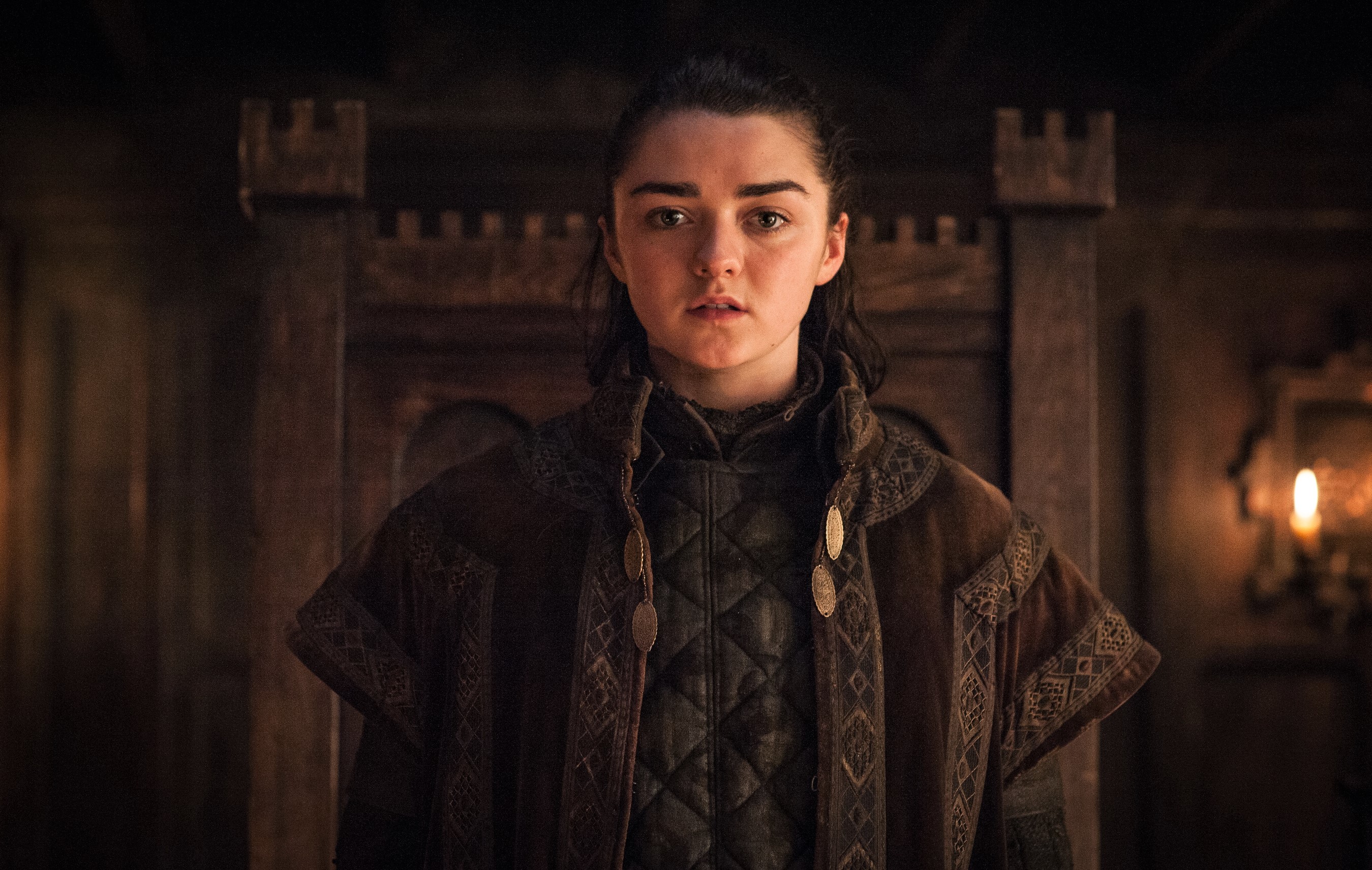By Marc N. Kleinhenz
There is this Game of Thrones theory floating around out there, and it goes a little something like this: “it’s easy for viewers to tell the demarcation point between where the HBO series stopped adapting the five published novels it’s based on and where it started to tell the remaining, unpublished story all by itself, left to the devices of its two showrunners, David Benioff and Dan Weiss.” This transition is an easily identifiable one, the argument maintains, because the narrative has changed in some pretty dramatic and obvious ways, becoming a lot safer and, thus, more predictable, with the various shocks and twists of author George R.R. Martin’s portion largely falling by the wayside.
Interestingly enough, a close examination of this critique reveals something pretty extraordinary: it’s both spot-on and completely without merit in equal measure. And explaining why this is so may help to calm some viewers’ apparent anxiousness heading into the series finale while also demystifying Martin’s writing process —and, just maybe, help explain why it’s now been taking him nearly a decade per book.
The fake-out factor
Let’s start with a very basic premise: A Song of Ice and Fire, George Martin’s sprawling, several-thousand-page saga, has always been, at its very foundation, a traditional story. From its very beginnings, for example, it established a core of just a few central characters – who even go on to survive that inconvenient state of affairs called death – who have very closely hewed to the traditional narrative progression that Joseph Campbell famously dubbed the Hero’s Journey; Jon Snow’s arc, in particular, seems to have sprung directly from that roadmap, but it just as equally applies to the likes of Arya Stark, Tyrion Lannister, and, perhaps most controversially now, Daenerys Targaryen.
What obscures this basic structure – besides the fact that Ice and Fire has yet to complete its planned seven-volume run, of course – is Martin’s exceptional ability to obscure it; a famous adage says that writing is like a giant magic trick, redirecting the audience’s attention over here while the set-up goes on over there – and George’s magic act is, in many ways, one of the most elaborate productions around. While Jon Snow rides off to join the Night’s Watch and begin a master course in leadership and self-sacrifice, for instance, Lord Eddard Stark is contending with the governing incompetence of King Robert Baratheon down south and the rising threat of Khal Drogo across the narrow sea; by the end of the first book, all three of these seemingly-major players are dead, and readers (and viewers!) are left with the feeling that the narrative groundwork underneath them has just buckled. In retrospect, the real character development is obvious and predictable, yet almost entirely hidden.
And this perfectly illustrates the first layer of this storytelling smokescreen: a pretty consistent level of fake-outs. Ned Stark’s beheading, the massacre that was the Red Wedding, the arrival of a prophesied savior in the form of King Stannis Baratheon, even the shifting identities of the man called Reek (in the books, first he was Ramsay’s indentured servant, then Ramsay himself in disguise, and then he was the forced identity of the former Theon Greyjoy) – they all are trotted out in a constant parade of reveals and revelations, keeping the reader guessing in the foreground while all the major work was going on in the background. In this way, audiences could be lulled into a false sense of shock and awe, that anyone could be killed off at any time for any reason (and in any manner) while, in reality, Jon could acquire so much “plot armor” that he could even be resurrected from death itself. It’s both simple and complex, pedestrian and poetic.
A peculiar narrative structure
Compounding all the fake-outs was another, more systemic wrinkle to George R.R. Martin’s storytelling modus operandi: each chapter would be told exclusively from the perspective of just one particular character. While this may sound straightforward on paper, it actually is employed to intricate dramatic effect – since the entire narrative playing field is severely restricted to a protagonist’s field of knowledge, there are many major plot developments or character beats that get lost in the cracks and which can only be surmised after the fact, like a detective trying to reconstruct a crime scene. The shifting loyalties of Roose Bolton, for example, fall squarely in this realm, meaning that an unobservant reader may find the northern lord’s infamous betrayal at the Red Wedding a whole book later somewhat abrupt; the disappearance of three Freys on the way to Ramsay Bolton’s wedding to a false Arya Stark (see? The fake-outs keep landing, even if readers happen to know this one while all the rest of the characters may not) and Wyman Manderly’s jubilant serving of three large meat pies at the reception are otherwise two completely unconnected events.
A corollary to this device is the introduction of previously-established “background” characters as POV protagonists in subsequent novels, a practice which helps to hide the importance of such figures as Jaime and Cersei Lannister to the overarching story (they aren’t added to the main roster until the third and fourth installments, respectively.) In this way, most readers of the first volume would never have jumped to the conclusion that Ser Jaime of the Kingsguard would be a pivotal mover and shaker in the saga’s endgame, never mind the fact that he’s actually one of the most nuanced and dynamic characters in the text.
Muddying the narrative waters even further is Martin’s regular deployment of the unreliable narrator, the fancy literary term for a protagonist who is either lying to the reader or who is mistaken in his conclusions or convictions. Thanks to this particular vein of obfuscation, entire historical developments are misunderstood and, therefore, extended to the wrong conclusions – the entirety of Robert’s Rebellion against the Targaryen Iron Throne was based on the lie that Lyanna Stark was forcibly taken from Robert Baratheon and then raped by Prince Rhaegar, which would ultimately unleash such further throes of misinformation as the War of the Five Kings, which saw the public operate under the false belief that Joffrey (and then Tommen) were Baratheon heirs.
It is this reading-between-the-lines approach to storytelling that has not only encouraged but probably necessitated the existence of companion ebooks and analytical websites to help audiences pick out overlooked throughlines and half-hidden thematic motifs – what may be the majestic hallmark of prose, but which had to be all but abandoned for the medium of television (all three of the Lannister progeny, for example, carry their own scenes and begin shuffling through their own character arcs right from the very first episode).
Bringing it all home to Game of Thrones
Given all this, when executive producers Dan Weiss and David Benioff sat down to do the impossible and adapt the seven-book Song of Ice and Fire to just 73 episodes of Game of Thrones, a number of key decisions had to be made on where to abridge and how to fill in the gaps – an obvious observation, admittedly, when it deals with a certain chapter being omitted or a certain sub-plot being condensed, but one that may not be quite as noticeable when it comes to such matters as fundamental story structure and narrative sleight of hand.
And no choice has been as consequential as limiting the size of the television series’s cast. Whereas the lineup of POV protagonists in books four and five explodes to something double or nearly triple what it was across the first three volumes, Benioff and Weiss made the decision to hold firm to just the two dozen or so characters that were largely introduced in the first two seasons of the show (a wise move, as Game of Thrones would otherwise be some five seasons longer); in this way, when a particular development befell a newly-inserted player in the novels, that plot beat had to be appropriated by a pre-existing television character, like when Lord Jon Connington secretly contracted greyscale and Ser Jorah Mormont became his HBO stand-in, or how Arya took over Lady Stoneheart’s vindictive crusade to execute all of House Frey.
This may have been born out of concerns of narrative efficiency, but it has also resulted in an unintended side effect: a number of the misdirections that George Martin continues to employ on the page in his (proposed) final two books are no longer available on the screen. As such, just as Jon Snow is being brought back from beyond the grave and Daenerys Targaryen is exerting control over nearly the entirety of the Dothraki horde, some of the final steps that begin to prepare both characters for the story’s endgame, there is no suddenly-revealed-to-still-be-alive Jon Connington and Aegon Targaryen landing their sellsword forces on Westeros – marking a Targaryen invasion several months, if not longer, before Dany would be able to do so. This, in turn, forestalls a number of military clashes and political cage-rattling for King Tommen and his royal mother, Cersei Lannister, and it doesn’t have the same effect on Lord Varys and Magister Illyrio Mopatis’s secret conspiracy to reinstate the Targaryen dynasty (which becomes terribly disrupted by the Dragon Queen’s sudden emergence as, perhaps, a worthier candidate for the Iron Throne). And, finally, all of this doesn’t even touch the possibility that little Aegon isn’t, perhaps, the real deal in the first place – meaning that even the fake-outs could themselves be the result of other fake-outs.
In terms of Game of Thrones, then, this necessarily results in an open, distraction-free field for Queen Dany to arrive in the Seven Kingdoms, fall in love with King Jon, and face off against Queen Cersei for control of the throne – a scenario which suddenly seems a lot more straightforward and, thus, predictable than anything that landed in the show’s first five seasons. But make no mistake about it: given the plethora of interviews that Martin, Benioff, and Weiss have all given over the course of the past several months, this fundamental state of affairs playing out in the source material seems to be all but guaranteed, meaning that Mhysa Dany’s controversial transformation from aspirational monarch to someone the people may remember as the true daughter of the Mad King is just as inevitable on the page as it has been on the screen.
We just need to see how many more thousands of pages George R.R. Martin needs in order to ultimately get there.
—
Marc N. Kleinhenz is the editor-in-chief of Orlando Informer. He’s also written for 31 other sites (including Screen Rant, IGN, and Tower of the Hand, where he serves as consulting editor), has appeared on radio and television news as a pop-culture specialist, served as a consultant on the theming industry, and has even taught English in Japan.
The post Game of Thrones hasn’t changed its storytelling – even though it sorta has appeared first on Watchers on the Wall.
Via http://watchersonthewall.com





No comments:
Post a Comment